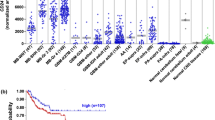Abstract
Immunohistochemical analyses with the monoclonal antibody D2-40 were performed to ascertain the expression of podoplanin (a.k.a. T1-alpha, gp36, or aggrus) in tumors of the central nervous system (CNS) and to determine the diagnostic utility of the antibody. The analyses were performed on 325 tumors of various histologic types. The chief finding was almost constant immunoreactivity in ependymal tumors (37/40, 92.5%), choroid plexus papillomas (8/8, 100%), and meningiomas (100/100, 100%). The reactivity was considered “tissue-specific,” as the corresponding normal tissue of each tumor was also found to express podoplanin. In addition, expression, not committed to the lineages, was found in many other tumor types, including astrocytic tumors, medulloblastomas, and hemangioblastomas, with variable frequency and intensity. The way of expression was not fully understood, but the expression in astrocytic tumors seemed to be associated with pronounced fibrous properties or malignant phenotype, as was shown by high-frequent expression in pilocytic astrocytomas (12/12, 100%) and glioblastomas (29/35, 82.9%). The present study has shown that podoplanin is expressed in several types of CNS tumors with variable frequency and intensity. Given the widespread expression of podoplanin, the antibody D2-40 is of little use in diagnostic practice for CNS tumors.


Similar content being viewed by others
References
Breiteneder-Geleff S, Matsui K, Soleiman A, Meraner P, Poczewski H, Kalt R, Schaffner G, Kerjaschki D (1997) Podoplanin, novel 43-kd membrane protein of glomerular epithelial cells, is down-regulated in puromycin nephrosis. Am J Pathol 151:1141–1152
Breiteneder-Geleff S, Soleiman A, Kowalski H, Horvat R, Amann G, Kriehuber E, Diem K, Weninger W, Tschachler E, Alitalo K, Kerjaschki D (1999) Angiosarcomas express mixed endothelial phenotypes of blood and lymphatic capillaries: podoplanin as a specific marker for lymphatic endothelium. Am J Pathol 154:385–394
Cenacchi G, Roncaroli F, Cerasoli S, Ficarra G, Merli GA, Giangaspero F (2001) Chordoid glioma of the third ventricle: an ultrastructural study of three cases with a histogenetic hypothesis. Am J Surg Pathol 25:401–405
Chu AY, Litzky LA, Pasha TL, Acs G, Zhang PJ (2005) Utility of D2-40, a novel mesothelial marker, in the diagnosis of malignant mesothelioma. Mod Path 18:105–110
Dumoff KL, Chu C, Xu X, Pasha T, Zhang PJ, Acs G (2005) Low D2-40 immunoreactivity correlates with lymphatic invasion and nodal metastasis in early-stage squamous cell carcinoma of the uterine cervix. Mod Path 18:97–104
Kahn HJ, Bailey D, Marks A (2002) Monoclonal antibody D2-40, a new marker of lymphatic endothelium, reacts with Kaposi’s sarcoma and a subset of angiosarcomas. Mod Path 15:434–440
Kato Y, Sasagawa I, Kaneko M, Osawa M, Fujita N, Tsuruo T (2004) Aggrus: a diagnostic marker that distinguishes seminoma from embryonal carcinoma in testicular germ cell tumors. Oncogene 23:8552–8556
Kawano N, Yasui Y, Utsuki S, Oka H, Fujii K, Yamashina S (2004) Light microscopic demonstration of the microlumen of ependymoma: a study of the usefulness of antigen retrieval for Epithelial Membrane Antigen (EMA) immunostaining. Brain Tumor Pathol 21:17–21
Kimura N, Kimura I (2005) Podoplanin as a marker for mesothelioma. Pathol Int 55:83–86
Ma T, Yang B, Matthay MA, Verkman AS (1998) Evidence against a role of mouse, rat, and two cloned human T1-alpha isoforms as a water channel or a regulator of aquaporin-type water channels. Am J Respir Cell Mol Biol 19:143–149
Marks A, Sutherland DR, Bailey D, Iglesias J, Law J, Lei M, Yeger H, Banerjee D, Baumal R (1999) Characterization and distribution of an oncofetal antigen (M2A antigen) expressed on testicular germ cell tumours. Br J Cancer 80:569–578
McComb RD, Eastman PJ, Hahn FJ, Bennett DR (1987) Cerebellar hemangioblastoma with prominent stromal astrocytosis: diagnostic and histogenetic considerations. Clin Neuropathol 6:149–154
Pasquier B, Peoc’h M, Morrison AL, Gay E, Pasquier D, Grand S, Sindou M, Kopp N (2002) Chordoid glioma of the third ventricle: a report of two new cases, with further evidence supporting an ependymal differentiation, and review of the literature. Am J Surg Pathol 26:1330–1342
Roy S, Chu A, Trojanowski JQ, Zhang PJ (2005) D2-40, a novel monoclonal antibody against the M2A antigen as a marker to distinguish hemangioblastomas from renal cell carcinomas. Acta Neuropathol (Berl) 109:497–502
Schacht V, Dadras SS, Johnson LA, Jackson DG, Hong YK, Detmar M (2005) Up-regulation of the lymphatic marker podoplanin, a mucin-type transmembrane glycoprotein, in human squamous cell carcinomas and germ cell tumors. Am J Pathol 166:913–921
Vortmeyer AO, Frank S, Jeong SY, Yuan K, Ikejiri B, Lee YS, Bhowmick D, Lonser RR, Smith R, Rodgers G, Oldfield EH, Zhuang Z (2003) Developmental arrest of angioblastic lineage initiates tumorigenesis in von Hippel–Lindau disease. Cancer Res 63:7051–7055
Zimmer G, Oeffner F, Von Messling V, Tschernig T, Groness HJ, Klenk HD, Herrler G (1999) Cloning and characterization of gp36, a human mucin-type glycoprotein preferentially expressed in vascular endothelium. Biochem J 341:277–284
Author information
Authors and Affiliations
Corresponding author
Rights and permissions
About this article
Cite this article
Shibahara, J., Kashima, T., Kikuchi, Y. et al. Podoplanin is expressed in subsets of tumors of the central nervous system. Virchows Arch 448, 493–499 (2006). https://doi.org/10.1007/s00428-005-0133-x
Received:
Accepted:
Published:
Issue Date:
DOI: https://doi.org/10.1007/s00428-005-0133-x




